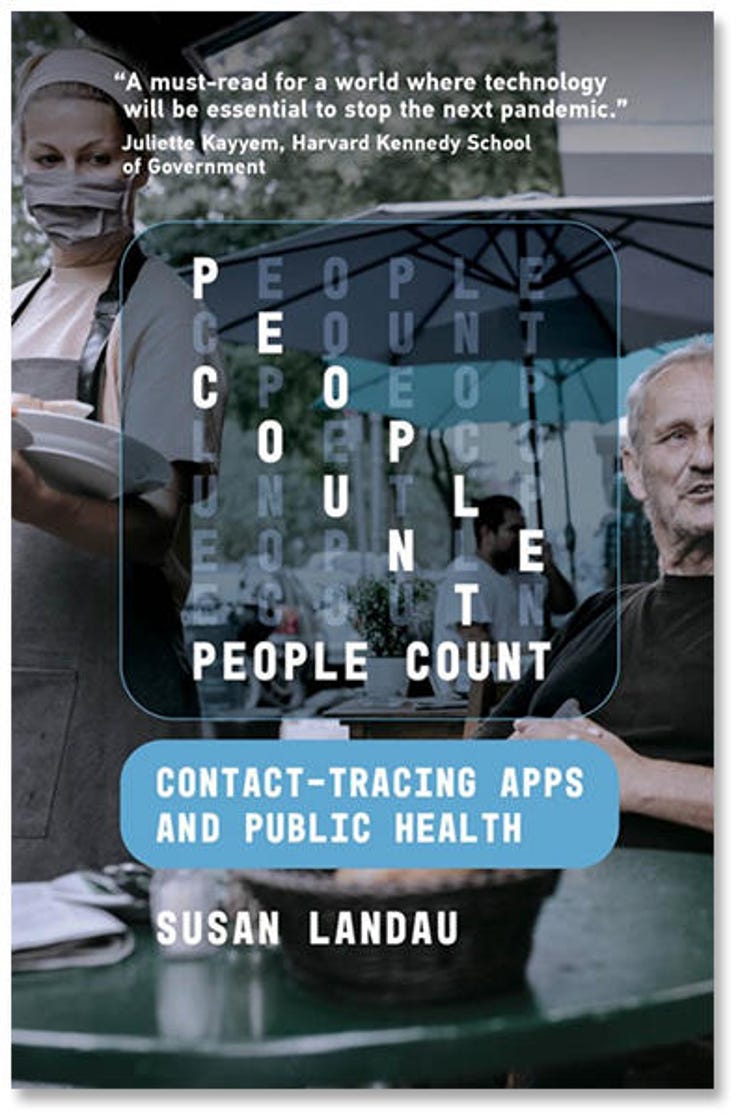People Count, book review: Technology, data, privacy and contact-tracing apps


People Count: Contact-Tracing Apps and Public Health • By Susan Landau • MIT Press • 165 pages • ISBN: 978-0-262-04571-1 • $24.95
Back in March 2020, when contact-tracing apps were first being frantically built, they seemed to me like a mirage -- a fantasy embraced by the smartphone-toting, jet-setting class who wanted to believe that technology could let them ignore the pandemic.
Prejudice does not make for good science, however, and in a pandemic good science is what we need. Now, a year and a half later, in People Count: Contact Tracing Apps and Public Health, Tufts University professor Susan Landau has set out to make a sober assessment.
You have to feel for her here, because writing a book about such a fast-moving topic is pretty much like trying to nail flan to the ceiling. Landau finished her book in the autumn of 2020. At that point, many countries were too locked down for contact-tracing apps to matter much; now, everyone's focused on vaccinations.
She begins with a general history of contact tracing, moves on to technology-enhanced contact tracing, the conflict between contact tracing and privacy, and an assessment of whether contact-tracing apps have been effective, and closes with a brief discussion of the future.
The big conflict in spring 2020 was whether contact-tracing apps should be centralised or decentralised -- that is, whether they should collect user data into a giant, government-managed database or keep data locally on each user's phone, to be shared only with that user's agreement following a positive test.
Landau follows this history and the near-universal adoption of the GAEN (Google-Apple Exposure Notification) decentralised platform now used by almost every app. Landau discusses the European effort (which included UCL in the UK), which developed privacy-protecting open-source protocols whose principles were similar to GAEN's eventual design. However, she leaves out 2011's FluPhone project, led by Jon Crowcroft and Eiko Yoneki at Cambridge, which established that using mobile phones could provide real-time measures of social activity and help identify superspreaders via the infections appearing around them.
Trust and local context
Landau concludes that while contact-tracing apps can clearly contribute to reducing the Basic Reproduction Number by uncovering cases that, without help, people cannot, the same is true of human contact tracing. As an example, she cites the Fort Apache Indian Reservation in Arizona, which skipped tests in favour of looking for symptoms such as low oxygen saturation. The result, despite many infections, was a death rate lower than that of the surrounding state.
Trust and an understanding of the local context are key, as is ensuring that the public health infrastructure works for those most in need. A better approach than GAEN, she argues, is to build apps that help contract tracers; she names the NHS app that collects QR code check-ins as an example.
Now, as things may be opening up, is the time when contact-tracing apps might have more of a role to play. We should, Landau concludes, have the public debate about how and when these tools should be used that we failed to have last year. This pandemic will end, but it won't be the last. We should prepare now.
RECENT AND RELATED CONTENT
Contact-tracing apps: Android phones were leaking sensitive data, find researchers
Singapore passes bill governing police use of contact tracing data
Contact-tracing app averted around 600,000 COVID infections, says study
Google fixes API bug in COVID-19 contact-tracing apps worldwide
NSW says QR codes are the most effective system for COVID-19 contact tracing
Read more book reviews
- Atlas of AI, book review: Mapping out the total cost of artificial intelligence
- Silicon Values, book review: A history of online censorship in the Big Tech era
- The Hype Machine, book review: Inside the 'social media industrial complex'
- The Hidden Power of Systems Thinking, book review: Reinventing governance
- Ask Your Developer, book review: How to prosper in a 'build or die' business landscape